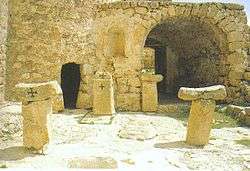Gülgöze, Mardin

Inwardo or Gülgöze (Syriac: ܥܝܢ ܘܪܕܐ - Iwardo or In wardo, Ayin Warda, Ain Wardo) (meaning "eye of the rose" in Syriac) – is a Syriac village that lies very high, east of the city Midyat, in the Mardin Province of Turkey, and can be reached from Midyat on foot in 2 hours. The village was founded some time around the 10th century.
History
World War I
Prior to the start of World War I, the village had about 200 families, and all were ethnic Syriacs that belonged to the Syriac Orthodox Church. During the Assyrian Genocide, tens of thousands of refugees from throughout Tur Abdin arrived here for safety. At one point, the number of Syriacs in the village was up to 21980 people. Refugees arrived from villages including Habasnos, Midyat, Bote, Keferze, Kafro Eloyto, Mzizah and Urnas. Even refugees from outside Tur Abdin arrived, coming from villages such as Deqlath, Bscheriye, Gozarto, Hesno d Kifo and Mifarqin.
Being aware of the Turks and Kurds were coming to Gülgöze, the Syriac villagers and refugees created a militia to defend themselves, which was led by Masud Mirza, the son of a Melik. Their resistance lasted 60 days, and ended in success.[1]
At the same time, the Kurdish authority of Midyat was given orders to attack Gülgöze and Arnas. However, Aziz Agha, the leader of the Midyat area, told them that they didn't have enough soldiers to attack both areas, and therefore they would attack Gulgoze only, and then go to Arnas later on. Therefore, The Kurds of Tur Abdin and Ramman, under the generalship of Ahmed Agha and Salem Agha, collected themselves in Mardin, and created a unit of 13,000 men. The government authorized the distribution of arms, and they headed towards Gülgöze, arriving late at night to begin the siege.
After hours of gun-battle, the Syriacs defeated the Kurds and drove them out, but there were many casualties on both sides regardless. After 10 days, The Kurds attacked again only to be beaten yet again, as they lost well over 300 men. Before the beginning of a third attempt, Kurdish leaders called for aid from the mayors of Diyarbakır(Raschid) and Mardin(Badri). However, A third attempt also failed and after 30 days of battle, Aziz Agha suggested a peace treaty between the two sides. 3 Syriacs met with Aziz to discuss a peace treaty, But the Syriac refused to lay down their weapons, thus the battle continued. The siege continued for another 30 days leading to many deaths on both sides. In the end, the Kurdish soldiers surrendered and left the Syriac of Tur Abdin alone, hence why the Tur Abdin region is the only Christian populated area left in Turkey outside of Istanbul. The total death toll of this 60-day siege is unknown, but there were at least 1,000 deaths with both sides losses combined.
Gülgöze today
Gülgöze has three Syriac churches: "Mart Shimuni", "Mar Hodtschabo" (the largest) and "Yoldath Aloho" (Virgin Mary, Literally: Mother of God).
Economy
Gülgöze produces grain, fruit, and wine. As in many villages in Turkey, the farmers operate a cattle economy.
Demographics
Currently, there are 12 Syriac families in the village. There is also a very sizable diaspora communities that originally come from Gülgöze:
- Germany: 200 Families
- United States: 140 Families
- Sweden: 90 Families
- Syria: 80 Families
- France: 40 Families
- Istanbul: 40 Families
- Lebanon: 20 Families
- Australia: 10 Families
References
- ↑ Gaunt, David; Bet̲-Şawoce, Jan (1 January 2006). Massacres, Resistance, Protectors: Muslim-Christian Relations in Eastern Anatolia During World War I. Gorgias Press LLC. p. 348. ISBN 978-1-59333-301-0.
Coordinates: 37°25′N 41°29′E / 37.417°N 41.483°E
